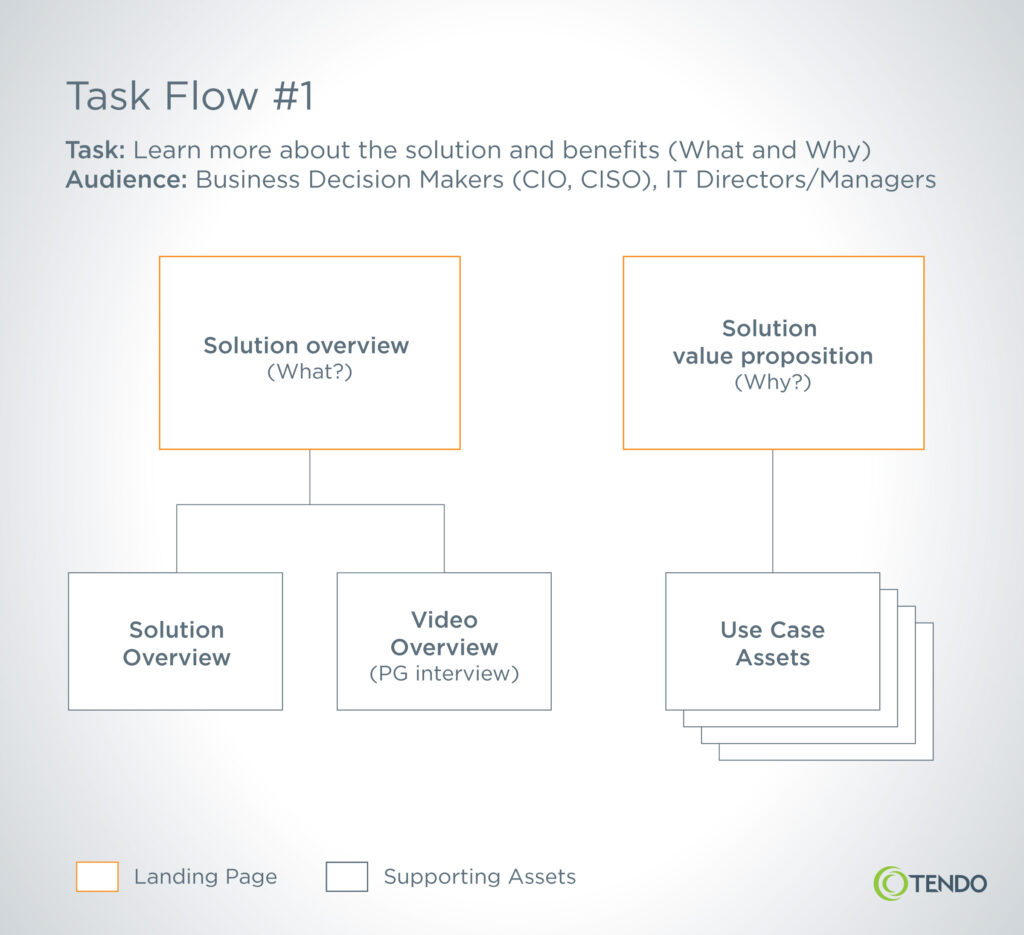What Is a Task Flow?
A task flow is a diagram that represents a user’s journey through a specific task or job to be done (JTBD). You can think of task flows as the DNA of content experience. Instead of viewing a single piece of content in isolation, a task flow allows you to consider how one piece of content connects to the next. These connections form the paths that users travel to arrive at their endpoint.
Before beginning content planning or creation, you can use task flows to figure out what your users are trying to accomplish. What are their main goals as they navigate your content? UX strategist Gerry McGovern calls these goals “top tasks.” Ideally, these top tasks or JTBDs will inform the endpoints of your task flow. And they will help keep the content experience laser focused on your users.

When to Create a Task Flow Diagram
Task flows can be informational or transactional. While they are often web-related, they do not need to be. For example, your commute to work can be represented by a task flow:

Think about times when you’ve been frustrated with a company’s website. Have you ever visited a restaurant’s site in search of a menu and hours of operation, only to get lost in a sea of irrelevant jargon and a long-winded mission statement? Those websites probably didn’t consider your task flow before building their site.
Five Questions to Consider When Making Task Flows
When creating user task flows, prioritize what matters most to your audience, not what matters most to you. By putting their needs first, you can increase engagement, conversion, and brand awareness. According to the Content Marketing Institute, 90% of top-performing B2B content marketers put their customers’ informational needs first.
Consider these questions to get a feel for your audience’s goals:
- What are their starting points?
- Why are they engaging with your brand?
- What information are they hoping to find?
- What action(s) do they want to complete?
- How do their goals intersect with your brand’s objectives?
What Goes into Developing Task Flows
In addition to focusing on your audience’s goals, it’s also important to get a holistic view of who your users are. Dig into their careabouts, behaviors, preferences, and pain points to create personas that represent real users, then map out their customer journeys. This will help you understand your customers’ top tasks or JTBD at every stage of their journey. With their top tasks identified, you can map out a task flow diagram of the steps users take to complete each one.
Activities that inform task flow development typically include:
- Interviews with key stakeholders in the organization—across sales, marketing, and customer support—to align business goals with customer needs
- User research gathered via a combination of interviews, surveys, customer call logs, and website and social analytics
- Competitor and market research
How Task Flows Support B2B Marketing
Task flows can help content marketers and strategists balance brand goals with customer needs. On one hand, businesses often approach content strategy from an “in the weeds” perspective. They prioritize their own brand objectives, and consider first how a piece of content can help them accomplish their goals. On the other hand, users don’t care about any of this—they care about their own needs. How can they quickly find the information they need? How can they accomplish their task as efficiently as possible?
Task flows do a good job of addressing both of these concerns. With a task flow, you can factor in business goals such as boosting brand awareness, while also ensuring that the user experience remains clear and straightforward. Intuitive navigation that’s streamlined against user needs—rather than cluttered with stakeholder asks—will keep customers from dropping off your site.
In addition, socializing these task flows helps build consensus and alignment not just within the marketing function, but also across multiple teams including sales and IT. This will help your entire organization be better equipped to address and support your users’ needs.
Lastly, task flows can help with high-level concepting in pre-layout stages of a project’s lifecycle. Due to the visual nature of content models, it’s easy to jump the gun and start thinking about layout prematurely. Task flows sidestep this issue by allowing you to consider content components in a non-visual way. The streamlined diagrammatic format makes it easy to focus on the content itself, which will in turn guide UX and visual direction.
Need Help Developing JTBDs and Task Flows?
Tendo can support you with our JTBD and task flow mapping services, laying the groundwork for a better content and user experience. We’re the agency of choice for world-class B2B brands. Let us know what your needs and goals are—contact us today.


